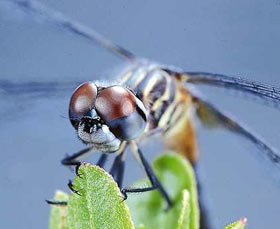Animal Eyes Provide High-Tech Optical Inspiration
Whales, for example, have an internal hydraulic system adapted to their air-breathing ocean existence.
A chamber behind the eye's lens alternately fills with fluid to move the lens closer to the retina and empties to move it farther away. This changes focal length in a way that allows the whales to enjoy clear sight above and below the water's surface.
The system may also help whales deal with the water pressure they experience at depth.
Lee has created polymer versions of whale-eye lenses in his lab for use in cameras and other equipment.
"If you can make a dynamic lens, you can change its curvature by the amount of pressure that you control," he said. "If a company could make an inexpensive, plastic, membrane-based lens, you wouldn't have to rotate [between different glass] lenses," he explained.
"You might just have one lens and a system that you can use to change the magnification." Such a system could someday replace "fisheye" type lenses, which capture a wider field of view.
"That's a huge monster, because there are actually many lenses in a fisheye lens," Lee said. "But if you can control [curvature] with a liquid, you can reduce all those layers of lens. By playing with this polymer you can do a lot."
360-Degree Sight
Lee and other researchers have created only components of camera-type eyes. But scientists are much closer to reproducing entire vision systems like the lenslets found in compound eyes.
Compound eyes, common in insects such as dragonflies, may utilize up to 29,000 lenslets per eye.
These individual lens systems, or ommatidia, function separately from each other. Each captures its own tiny piece of the overall picture.
All these tiny images are processed simultaneously in the eye, which enables insects to have outstanding fast-motion detection.
"People buy those [kaleidoscopelike] things where you see a whole bunch of little images that look pretty much like the same image. That's not at all what insects see," said dragonfly-vision expert Robert Olberg.
Olberg explains that compound eyes afford a panoramic view, allowing insects to see in many directions at once. "The dragonfly's field of vision is actually 360 degrees," said Olberg, a biology professor at Union College in Schenectady, New York.
"They can look back and see their wings going up and down, though their vision isn't very acute in that direction."
Dragonflies enjoy a wide field of vision, but clarity is much higher for them within a limited arc 60 degrees above the horizon.
"You can really think of it that if you have a thousand ommatidia, you have a picture that's made of a thousand pixels, and the pixel size varies over the image."
To make artificial compound eyes similar to insect eyes, researchers combine a polymer lens with a tubelike "waveguide," which connects to an optoelectronic detector that recognizes images.
Lee has created 180-degree hemispheres with ommatidia of this type, though they may display only half of the possible picture.
"In our case we can bond two [half hemispheres] together for a 360-degree view," Lee said. "We can create an omnidirectional sensor that can also detect fast movement—the insect eye is very good at fast movement."
Surveillance is an obvious candidate for such an application. Sensors could constantly monitor locales in 360 degrees and real time, from parking lots to the skies above major cities.
Lee also notes that imaging sensors could theoretically take Fantastic Voyage-esque journeys inside the human body.
"They can be made small enough to be swallowed," he notes, "which would allow doctors to see 360-degree images of the entire digestive system."
Lee believes that such breakthroughs will be greatly aided by flexible, three-dimensional polymers, which were unavailable to researchers in previous decades of animal-vision study.
"It's not that we're smarter today—past researchers were very smart to identify so many details of the eye," he said. "But they didn't have the tools that we have."
Free E-Mail News Updates
Sign
up for our Inside National Geographic newsletter. Every two
weeks we'll send you our top stories and pictures (see
sample).
MOST POPULAR STORIES
Photo in the News: Oldest Known Maya Mural Reveals Royal TaleArchaeologists have revealed the final wall of the earliest known Maya mural, sa... |
Oldest Known Maya Mural, Tomb Reveal Story of Ancient KingArchaeologists have revealed the final wall of the earliest known Maya mural, sa... |
King Kong Island Home Is Pure Fantasy, Ecology Experts SaySkull Island, the mythical home of the great ape King Kong, is supposed to lie i... |
|
||||||||||









